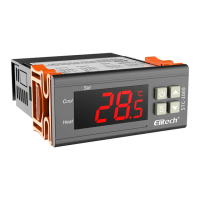Haswill Electronics
1 / 2
User Manual of STC-1000 Thermostat
Heating and Refrigeration Auto Switch Controller
(Version 21.08.04GEN)
STC-1000 temperature controller regulates the temperature by turn on/off the power status
of the connected load.
Within dual individually relays, this unit could connect two loads simultaneously, one for
refrigeration, another for heating, and the heating and the refrigeration controlling modes
auto switch according to the room sensor temperature; that's why it was called "All-Purpose
Temperature Controller."
1. Package
2. Specification
220V AC ± 10% 50/60HZ; (12/24/48/110V Option)
10A (Default) under 220V AC
NTC Sensor (NTC), 25°C /10 KΩ, the sensor cable 200cm
-10°C ~ 60°C, RH<90%, without condensation
3. Environmental Information
Package:
The package's material is 100% recyclable. Just dispose of it through
specialized recyclers.
Product:
The electro components can be recycled or reused if it is disassembled
for specialized companies.
Disposal:
Please do not burn or throw the controllers in domestic garbage.
Observe the respective law in your region concerning the
environmentally responsible manner of disposing of its devices.
4. Interface & Operation
4.1. Front Panel & Icon
Under normal status
Press the key to check the temperature set-point F1;
Press the key to check the Hysteresis value F2;
Hold the key for 3s to power off / on;
Hold the key and the key at the same time for 5s to restore factory settings
4.2. Indicators / Characters
Indicator
Meaning Light on Light off Light Flashing
4.3. Dimensions & Installation
A. Suggested amount dimension: 71 * 29 * 85 + mm (W*H*D)
B. Detach the slide fasteners, put the controller into the hole, wiring follow the diagram
C. Install the fasteners, and install the waterproof cover
D. Please avoid installing in the below environments:
Relative humidity > 90%, have condensation.
The places that temperature <-10°C or >60°C.
The places that have inflammable and explosives.
Strong vibration or struck.
Exposed to the continuous water mist spraying.
Exposed to the dust.
Exposure to corrosive and pollution gas (gas, smoke, or salt fog that contains
sulfur or ammonia.
Wireless electromagnetic interference or strong magnetic fields (near to
transmitting antenna or switch board room);

